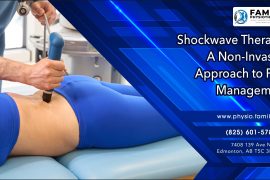In the evolving landscape of medical treatments, shockwave therapy has emerged as a groundbreaking, non-invasive approach to managing pain and promoting tissue healing. Particularly in Edmonton, this modality, offered by clinics like Family Physiotherapy Edmonton, is gaining popularity due to its effectiveness in treating various musculoskeletal conditions without the need for surgical intervention.
Understanding Shockwave Therapy
At its essence, shockwave therapy utilizes high-energy sound waves transmitted through the skin and into the affected muscles and tissues. These waves stimulate the body’s natural healing processes, making it an ideal treatment for a range of chronic and acute conditions.
The Science Behind Shockwave Therapy
Shockwave therapy operates on a principle that might seem simple but is profoundly effective in its execution. The treatment involves the application of high-energy sound waves, which penetrate the skin and directly impact the deeper tissues and muscles.
These sound waves induce microtrauma in the affected areas, a process that might sound counterintuitive at first but is crucial for stimulating the body’s intrinsic healing mechanisms. This process leads to increased blood flow, the breakdown of calcified tissue, and the stimulation of cell regeneration.
Moreover, it promotes the release of certain neurotransmitters that inhibit pain, providing immediate relief from discomfort. This multifaceted biological response is what makes shockwave therapy so uniquely effective, particularly in tackling chronic pain conditions where other treatments may fall short.
Conditions Treated by Shockwave Therapy
- Plantar Fasciitis: A common condition causing heel pain, plantar fasciitis can be effectively managed with shockwave therapy by promoting tissue healing and reducing inflammation.
- Muscle Pain and Injuries: For muscle strains or chronic muscle pain, shockwave therapy offers a way to stimulate blood flow and accelerate recovery.
- Calcific Shoulder Tendinitis: This condition, characterized by the presence of calcium deposits in the shoulder tendons, often leads to severe pain and restricted movement. Shockwave therapy helps break down these calcifications, thereby reducing pain and improving shoulder function.
- Achilles Tendinopathy: For those suffering from chronic Achilles tendon pain, often seen in runners and athletes, shockwave therapy can stimulate blood flow and tissue regeneration, alleviating pain and enhancing mobility.
- Patellar Tendinopathy (Jumper’s Knee): Common in athletes who engage in jumping sports, this knee pain can be significantly reduced with shockwave therapy, which promotes tissue healing and reduces inflammation.
- Tennis Elbow and Golfer’s Elbow: These conditions, resulting from repetitive strain to the elbow tendons, can be effectively managed with shockwave therapy by relieving pain and stimulating the healing of tendons.
- Hip Bursitis: Characterized by inflammation of the bursa in the hip, shockwave therapy can reduce the inflammation and pain associated with hip bursitis, improving the range of motion and functionality.
- Chronic Hamstring Issues: Athletes suffering from chronic hamstring strains or tendinopathy can benefit from shockwave therapy. It helps in reducing pain and accelerating the recovery of the hamstring muscles.
- Shin Splints: A common issue among runners, shockwave therapy, can address the inflammation and pain associated with shin splints, aiding in a quicker return to activity.
- Osteoarthritis Pain Relief: For individuals suffering from osteoarthritis, especially in the knees and hips, shockwave therapy can help alleviate pain, reduce stiffness, and improve joint function, thereby enhancing overall mobility.
- Scar Tissue Treatment: Shockwave therapy can be used to break down and reduce scar tissue, improving the range of motion while reducing discomfort associated with thickened scar tissue.
The Process of Shockwave Therapy
- Initial Consultation: A thorough assessment is key to determining whether shockwave therapy is the most appropriate treatment for the patient’s specific condition. Once it’s deemed suitable, the actual therapy process is relatively straightforward.
- Treatment Sessions: The treatment involves a device that emits high-energy sound waves, which the therapist directs at the targeted area. Typically, a course of treatment involves several sessions, each lasting only a few minutes. The number of sessions differs depending on the severity of the condition. The number of sessions required varies depending on the severity and nature of the condition.
- Post-Treatment Care: Patients may experience temporary soreness after treatment, which is a normal response as the body initiates its healing process.
Advantages of choosing Shockwave Therapy
- Non-Invasive: One of the most significant advantages is its non-invasive nature, eliminating the risks associated with surgery.
- No Need for Medication: Shockwave therapy reduces or even eliminates the need for pain medication, offering a safer alternative for pain management.
- Quick Sessions and Fast Results: The therapy sessions are quick, often under 30 minutes, and many patients experience relief after just a few treatments.
Embracing Pain Management Techniques
Shockwave therapy represents a significant leap in pain management and tissue healing. For residents in Edmonton, clinics like Family Physiotherapy Edmonton offer a gateway to this treatment, providing relief from pain and improving the overall quality of life for individuals suffering from various painful conditions. As a non-invasive, efficient, and effective treatment, shockwave therapy in Edmonton stands as a testament to the advancements in modern medical technology, offering a beacon of hope to those seeking an alternative to traditional pain management methods.


